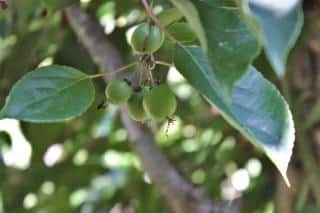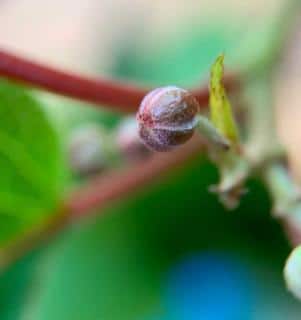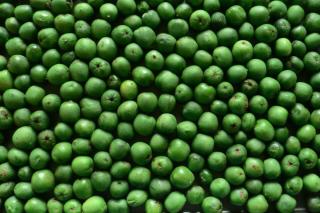

The tiny, sweet hardy kiwi actually comes from a gigantic and productive vine.
Hardy kiwi key facts
Botanical name – Actinidia arguta
Common name – hardy kiwi
Family – Actinidiaceae
Type – vine
Height – 6 feet (5 m)
Planting distance – 6 to 10 feet (2 to 3 m)
Exposure – full sun, no wind
Soil – cool, rich, light, well-draining, not chalky
Planting – fall, spring
Harvest – September-October
Hardy kiwi, sometimes called Siberian kiwi, is a tendril-forming vine native to Asia. It belongs to the Actinidaceae family, just like its relative the more common kiwi (Actinidia chinensis or Actinidia deliciosa).
Hardy kiwi can vine to heights over 15 feet, and it’s covered with lovely heart-shaped deciduous leaves. Blooming begins at the beginning of summer: whitish-green flowers with violet-red anthers appear. They’re very fragrant and bear a lot of nectar for bees. When the specimen you’ve planted is a female one, or if it’s a self-pollinating variety, the blooming is followed by the emergence of oval berries. Each berry is smaller than that of the regular kiwi, and its skin is smooth and thin. They’re also sweeter and contain even more vitamin C and calcium.
The tangy taste of hardy kiwi is very similar to that of gooseberry.
Sowing Siberian kiwi takes place at the beginning of spring, but you can also start your seedlings indoors or in a greenhouse anytime in fall. If you’re growing kiwi from seed taken from the current year’s fruits, then you must keep them in the refrigerator for 8 to 12 weeks. This simulates spending a winter out in the cold, which is necessary to trigger germination.
Fall is when you should transplant your hardy kiwi to the ground. Note, however, that if you live in places where winter is harsh, it’s best to transplant it in spring so that it can settle in during the summer before facing its first cold winter.
 Prepare a hole with cool, rich, light and well-draining soil to plant your hardy kiwi in. It hates soil that’s soggy or often flooded. And, most of all, it shouldn’t be chalky/limestone.
Prepare a hole with cool, rich, light and well-draining soil to plant your hardy kiwi in. It hates soil that’s soggy or often flooded. And, most of all, it shouldn’t be chalky/limestone.Dig the planting hole 2 feet (50 cm) across, and make sure you space the plants by 6 to 10 feet on all sides.
Hardy kiwi is a very hardy plant. It can resist colds down to -4°F (-20°C). In most parts of the temperate world, you can grow it outdoors directly in the ground without any problems at all.
 If ever you’ve planted hardy kiwi varieties that aren’t self-pollinating, then you should plant at least one male specimen so that all the other female specimens may find pollen to bear fruit. One single male is usually enough to fertilize 5 or 6 female specimens.
If ever you’ve planted hardy kiwi varieties that aren’t self-pollinating, then you should plant at least one male specimen so that all the other female specimens may find pollen to bear fruit. One single male is usually enough to fertilize 5 or 6 female specimens.
The Siberian kiwi vine requires a trellis that’s sturdy and strong (lattice, pergola, tree trunk, fence…). Keep the soil cool in summer thanks to regular watering (1 or 2 times a week when the weather is hot). A layer of plant mulch 4 to 6 inches thick (10 to 15 cm) will be a big help to your hardy kiwi on those hot days.
Hardy kiwi isn’t very vulnerable to attack from pests, except for red spider mite. This pest typically appears when the weather is both hot and dry.
 A hardy kiwi usually needs 2 to 3 years after planting before bearing its first few fruits. When fruiting has started, you’ll have a continuous supply from September to October, so make it a point to check on the vine every couple days to see what’s ripe for the picking.
A hardy kiwi usually needs 2 to 3 years after planting before bearing its first few fruits. When fruiting has started, you’ll have a continuous supply from September to October, so make it a point to check on the vine every couple days to see what’s ripe for the picking.
You can also pick a hardy kiwi even if it isn’t quite ripe yet: it’ll ripen still even when you’ve picked it off the plant.
In any case, expect a picked hardy kiwi to keep for at most one or two weeks. You usually eat it fresh and raw; there’s no need to peel it.
This kiwi’s taste is ideal to give a delicious twang to your fruit salads. It’s also surprisingly tasty in sweet & sour dishes. Those who like baking can make pies, muffins, and even ice cream from it. Another option to make the most of your ripe hardy kiwis is to drink them: blend them to prepare juice, slice them into punch, or distill them to brew wine. Lastly, hardy kiwi preserves are also easy to succeed: jam, sauce and jelly.
Some varieties are easier to find than others. For instance, the ‘Issei’ or ‘Issai’ variety is easier to get your hands on. It bears fruits that are very sweet! It’s a self-pollinating variety.